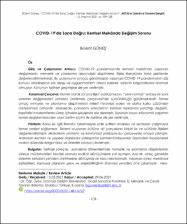COVID-19’da Sona Doğru: Kentsel Mekânda Değişim Sorunu
Özet
Giriş ve Çalışmanın Amacı: COVID-19 pandemisinde kentsel mekânda yaşanan değişimlerin, mimarlık ve planlama alanındaki disiplinlerle ilişkisi literatürde farklı şekillerde değerlendirilmektedir. Bu çalışmanın amacı, günümüzde yaşanan COVID-19 pandemisinin söz konusu disiplinlerce ele alınışı ve uygulamalarını analiz ederek, sürecin kırılganlıklarını aramak olmuştur. Konunun tarihsel geçmişine de yer verilmiştir.
Kuramsal Çerçeve: Genel olarak soruna ilişkin yaklaşımların, “yeni normal” anlayış ile yani sistemin değişmeden yeniden üretilmesi çerçevesinde sürdürüldüğü görülmektedir. Temel amaç mimarlık ve planlama disiplinlerinin riskleri minimize eden ve daha kalıcı çözümleri üretebilmesi olmalıdır. Makalede, pandemi süreçlerinin kentsel mekânda yarattığı değişim, kapitalist modernitenin süreç içindeki işleyişinde ele alınmıştır. Sorunun sosyo-ekonomik yaşamın temel değişkenlerinden olan üretim biçimi ile ilişkisine de yer verilmiştir.
Yöntem: Konu ile ilgili literatür taramasıyla elde edilen analizler ve sentezler çalışmaya temel verileri sağlamıştır. Sistemi oluşturan bütüne ait parçaların birbiri ile ve bütünle ilişkileri değerlendirilmiştir. Makalenin yöntemi ve kavramsal yaklaşımı bu çerçevede ortaya çıkmıştır. Ardından kentsel ve yapısal alanlarda yaklaşımlar kentsel fonksiyonlar üzerinden incelenerek makro düzeyde kırılganlıklar ve öneriler ortaya çıkarılmıştır.
Bulgular: Tarihsel süreçte, pandemi dönemlerinde mimarlık ve planlama disiplinlerinin sürece müdahaleleri kentsel alanda radikal dönüşümlere yol açmıştır. Ancak, süreç genelde sistemin kendisini yeniden üretmesine dönüşmüş ve kalıcı olamamıştır. Yaşanan süreç mekânsal eşitsizlikleri, kamusal alanların işlevi ve erişilebilirliğinin önemini yeniden öne çıkarmıştır. Neo-liberal küresel sistemin kentsel alanda demografik yapı ve yapılı çevrede yarattığı paradoksal sonuçlar halen süregelmektedir.
Sonuç: Mimarlık ve planlama disiplinlerinin mevcut sosyo-ekonomik işleyişteki kırılganlıklar üzerinden yaklaşımı ve tasarımı, riskleri minimize edebilecektir. Pandemide geliştirilen güncel kriterler kalıcı çözüm için yeterli olmayacaktır. Özellikle, neo-liberal küresel anlayışın yarattığı, planlama alanını dışlayan ve yapılı çevrede süregelen tüketim olgusuna dayalı tasarımsal yaklaşımlar ve uygulamalardan kaçınılmalıdır. Konu ile ilgili 20.yy başlarında ortaya çıkan, günümüze kadar gelen modernizmin içinde doğan, minimalizm ve bilimsel planlama anlayışı sürdürülebilirlik kavramıyla birlikte yeniden geliştirilerek değerlendirilmelidir. Introduction and Purpose of Study: The relationship between the changes in the urban space during the COVID-19 pandemic and the disciplines in the field of architecture and planning is evaluated in different ways in the literature. The aim of this study was to analyze the current COVID-19 pandemic by the disciplines and their applications, and to look for the vulnerabilities of the process. The historical background of the subject is also included.
Theoretical Framework: In general, it is seen that the approaches to the problem are maintained within the framework of the "new normal" understanding, that is, the reproduction of the system without changing. The main purpose should be the architecture and planning disciplines to produce more permanent solutions that minimize risks. In the article, the change created by the pandemic processes in the urban space is discussed in the functioning of capitalist modernity in the process. The relationship of the problem with the mode of production, which is one of the basic variables of socio-economic life, is also included.
Method: Analyzes and syntheses obtained from the literature review on the subject provided the basic data for the study. The relations of the parts of the whole that make up the system with each other and with the whole are evaluated. The method and conceptual approach of the article emerged within this framework. Then, approaches in urban and structural areas were examined through urban functions, and macro-level vulnerabilities and suggestions were revealed.
Findings: In the historical process, the interventions of architecture and planning disciplines in the pandemic periods have led to radical transformations in the urban area. However, the process generally turned into the system's reproduction of itself and could not be permanent. The process has brought the spatial inequalities, the function and accessibility of public spaces to the fore again. The paradoxical consequences of the neo-liberal global system on the demographic structure and built environment in the urban area still continue.
Conclusion: The approach and design of architecture and planning disciplines based on the vulnerabilities in the current socio-economic functioning will be able to minimize the risks. The current criteria developed in the pandemic will not be sufficient for a permanent solution. In particular, design approaches and practices based on the phenomenon of consumption created by the neo-liberal global understanding, excluding the planning area and continuing in the built environment, should be avoided. The understanding of minimalism and scientific planning, which emerged in the early 20th century and was born in modernism, should be re-developed and evaluated together with the concept of sustainability.
Cilt
1Sayı
1Bağlantı
https://hdl.handle.net/11363/2845Koleksiyonlar
Aşağıdaki lisans dosyası bu öğe ile ilişkilidir:


















